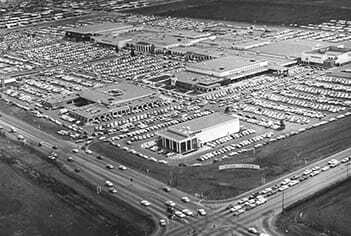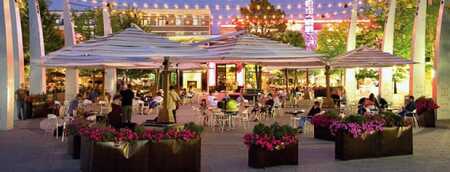
The enclosed and outdated Villa Italia Mall in Lakewood, Colorado, was demolished by Denver-based Continuum Partners and replaced with Belmar, a thriving open-air center that has 900,000 square feet of retail space, 269,000 feet of office space, public areas, and 1,300 apartments and for-sale homes. The complicated project included division of a 104-acre chunk of land into 22 city blocks, use of a U.S. Environmental Protection Agency loan to clean up contaminated soil, and the leveraging of tax incentives to install a network of solar panels and other generators of renewable energy.
Some retail owners have been able to turn their fortunes around by launching massive remodeling programs, adding new features, tweaking their tenant mix, and altering their marketing strategies. But sometimes the best choice is to simply tear down the building and start over—as in the case of Belmar, a now-thriving retail and residential development in Lakewood, Colorado.
Lakewood is a city of about 150,000 located eight miles (12.9 km) west of Denver. Before the area was incorporated, its hub was Villa Italia Mall, a 1.4 million-square-foot (130,000 sq m) enclosed regional center that was ringed by asphalt parking lots on a 104-acre (42 ha) plot of land.
- Related: Reinventing Inner-Ring Suburbs
- Case Study: Belmar in Lakewood, Colorado, Provides Year-Round Activities
The mall opened to great fanfare in 1966 and flourished into the early 1980s. But then a gradual decline began, caused in part by a slowing economy, growing competition, and poor maintenance. By the time the center finally closed its doors in 2001, three of its four anchors had left, as had many of its smaller retailers.
Local officials wanted the project to be redeveloped, but knew it would not be easy. The mall was owned by one entity but stood on land leased from another, and the two did not see eye-to-eye. The soil beneath it was contaminated by chemicals that had streamed from two dry-cleaning businesses inside the old mall, and the nationwide push to make future developments across the country more environmentally friendly was gathering steam. Several potential buyers looked at the property but quickly backed away.
The city approached two-year-old Continuum Partners in 1999. “The project seemed a little overwhelming, but we could also see the site’s potential,” says Mark Falcone, founder and chief executive officer of the Denver-based company. “The location was good, and so were the demographics. It was an opportunity that we couldn’t afford to pass up.”
Continuum promptly bought the land and in 2002 acquired the mall itself. Demolition began soon thereafter, and the company secured a $2 million loan from the U.S. Environmental Protection Agency through a coalition of the state and local governments to help pay for cleanup of the toxic soil.
“We wanted to build an ‘urban’ mall in this suburban setting, so we decided to break this 104-acre hunk of land into 22 city blocks,” Falcone says. Plans were drawn to replace the demolished mall with a 3.5 million-square-foot (325,000 sq m) mixed-use, pedestrian-friendly “downtown district” to include not just an open-air mall, but also office space, green areas, a public arts program, and 1,300 for-sale single-family residences, townhouses, and condominiums, as well as loft-style rental apartments.
Renewable energy was a priority from the start, Falcone says. Continuum leveraged a variety of tax incentives to help offset the cost of installing a network of 8,370 solar panels atop Belmar’s three parking garages, providing all the power needed to light each parking stall below. The parking meters are solar powered, too, and energy needed for streetlighting comes from wind turbines on top of the light poles.
The first phase of the $750 million project was completed about four years ago. Today, Belmar’s 900,000 square feet (84,000 sq m) of retail space is 95 percent occupied by retailers that include Target and Dick’s Sporting Goods, several boutique shops, restaurants and outdoor cafés, and a large theater complex. Its 269,000 square feet (25,000 sq m) of professional office space is fully leased.
Belmar now generates about $17 million annually in tax revenue for Lakewood, Falcone says, more than four times the amount the old mall produced.
Even more tax revenue will be generated—and more energy saved—as the project glides toward completion. Two residential builders that bought parcels inside the master-planned community are finishing the last 400 new rental apartments and for-sale homes around Belmar, which will increase local property tax collections. Belmar has also contracted with a local shuttle bus company to provide free rides to and from a new light-rail depot that recently opened one mile (1.6 km) away, allowing shoppers from Denver and outlying areas to leave behind their cars, save gas, and reduce carbon emissions.
Durango, Colorado–based GF Properties Group recently acquired a majority stake in the entire project and is now working with Continuum to build a hotel on the remaining land.
“It will probably be a limited-service hotel, like a Hyatt Place or Courtyard by Marriott,” Falcone says. “But right now, all I can say with certainty is that it will be ‘green.’”
Those interested in more on this subject may wish to download ULI’s Shifting Suburbs report.


![Western Plaza Improvements [1].jpg](https://cdn-ul.uli.org/dims4/default/15205ec/2147483647/strip/true/crop/1919x1078+0+0/resize/500x281!/quality/90/?url=https%3A%2F%2Fk2-prod-uli.s3.us-east-1.amazonaws.com%2Fbrightspot%2Fb4%2Ffa%2F5da7da1e442091ea01b5d8724354%2Fwestern-plaza-improvements-1.jpg)


